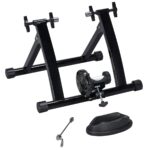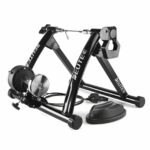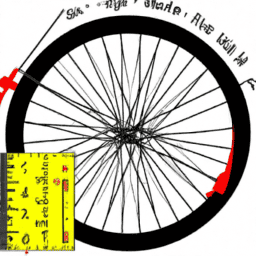Being a fitness aficionado, I understand the significance of maintaining your exercise regimen, regardless of unfavorable weather conditions. It doesn’t matter if it’s excessively cold, overly hot, or particularly rainy outdoors, it should not serve as a reason to forego your regular workout.
That’s why I’m excited to share with you a simple and cost-effective solution to turn your bicycle into a stationary bike, so you can continue your cycling workouts indoors.
By following these easy steps, you can create a comfortable and safe indoor cycling environment that allows you to train at your own pace, without worrying about traffic, weather, or other outdoor distractions.
All you need is a bike stand, a trainer tire, and a few minutes of your time to set up your new indoor cycling station. So, let’s get started and turn your regular bike into a powerful indoor training machine!
Key Takeaways
- To turn a bicycle into a stationary bike, you will need a bike stand, trainer tire, front wheel block, and sweat guard.
- Trainer tires offer better grip, reduced noise, and can withstand heat and wear and tear. Choose one that is the same size as your existing tire with a smooth tread pattern and consider its hardness.
- A bike computer can provide accurate data, monitor heart rate, and track calories burned. Some of the best models include Garmin Edge 1030, Wahoo ELEMNT Bolt, and Polar V650.
- It is important to warm up before an indoor cycling workout to increase blood flow, improve range of motion, and decrease the risk of injury. A proper cool-down with gradual pedaling and stretching can also prevent muscle soreness and improve flexibility. Creating a structured workout plan with intervals of high and low intensity, varying playlist, and proper form can help achieve the benefits of indoor cycling.
Gather the Necessary Equipment
You’ll need to gather all the necessary equipment to set up your stationary bike, including a bike trainer, a front wheel block, and a sweat guard. Choosing the right stand for your bike is essential in making sure that it fits securely and safely.
There are different types of bike stands available, including direct drive trainers, wheel-on trainers, and rollers. Direct drive trainers offer a more realistic feel, while wheel-on trainers tend to be more affordable and easier to set up. Rollers, on the other hand, require more skill and practice to use.
Another essential piece of equipment is a stationary bike tire. This type of tire is specifically designed for indoor cycling and provides a smoother, quieter ride while reducing wear and tear on your bike. It also helps to minimize vibrations and noise, making it more comfortable for you to train indoors.
Using a stationary bike tire also prolongs the life of your regular bike tire, as it won’t be subjected to the same wear and tear as it would when used on a trainer. With all the necessary equipment gathered, it’s time to set up your bike stand.
Set Up Your Bike Stand
Once the stand is in place, simply attach your rear wheel to it using the quick release or axle nuts. Choosing the right bike stand is crucial in ensuring stability and safety. There are different types of stands available in the market, ranging from simple and basic to sophisticated and feature-rich. Factors like your budget, the type of bike you use, and the intensity of your workout should be considered when selecting the right stand.
Proper bike positioning is also essential when using a bike stand. Adjust the height and angle of the bike to suit your comfort level and ensure that it’s stable and secure. A slight tilt forward is recommended to allow for a more natural and comfortable riding position.
Once you’ve set up your stand and positioned your bike correctly, you can proceed to install the trainer tire for a smoother and quieter ride.
Without further ado, let’s move on to the next step – installing the trainer tire.
Install the Trainer Tire
To get started with installing the trainer tire, simply deflate your rear wheel. This will ensure that you can easily remove the existing tire and replace it with the trainer tire.
Once you’ve deflated the tire, remove it from the wheel and install the trainer tire following the manufacturer’s instructions.
Here are some things to keep in mind when choosing and installing a trainer tire:
- Benefits of trainer tires: Trainer tires are specially designed to withstand the heat and wear and tear of indoor cycling. They also offer better grip and reduced noise compared to regular bike tires.
- Choosing the right trainer tire for your bike: Make sure to choose a trainer tire that is the same size as your existing tire. Look for a tire with a smooth tread pattern to reduce noise and vibration. It’s also important to consider the hardness of the tire. A harder tire will last longer, but may not provide as much grip as a softer tire.
- Inflate the trainer tire to the recommended pressure before use: This’ll ensure the tire is properly seated on the wheel and reduce the risk of damage to the tire or the trainer.
- Check the tire pressure before each ride: This’ll ensure that the tire is properly inflated and reduce the risk of damage to the tire or the trainer.
- Replace the trainer tire when needed: Like any tire, a trainer tire will wear out over time. Keep an eye on the tread and replace the tire when it becomes worn.
Now that you’ve installed your trainer tire, you’re one step closer to turning your bike into a stationary bike. The next step is to connect your bike to the trainer.
Connect Your Bike to the Trainer
Now that I’ve installed the trainer tire on my bike, it’s time to connect it to the trainer. This involves adjusting the resistance of the trainer, using a bike computer to track my progress, and taking necessary safety precautions.
I’ll need to make sure the resistance is set correctly for my fitness level. I’ll also use a bike computer to monitor my speed and distance. And of course, I’ll take care to follow all safety guidelines to prevent accidents.
Adjusting the Resistance
Get ready to feel the burn as you crank up the resistance on your newly transformed stationary bike. Adjusting the resistance on a stationary bike is essential to achieve the desired workout intensity. Most trainers have a resistance unit that allows you to increase or decrease the resistance by using a remote control or a lever on the unit itself. However, before you start, it is important to know how to choose the right resistance level that suits your fitness goals and how to address common issues that may arise.
To help you choose the right resistance level, refer to the following table:
| Resistance Level | Intensity | Use for |
|---|---|---|
| 1 | Easy | Warm-up, recovery, low-impact cardio |
| 2 | Moderate | Endurance training, fat burning |
| 3 | Difficult | High-intensity interval training, hill climbing |
| 4 | Very difficult | Sprint intervals, strength training |
If you experience any issues with the resistance, such as the trainer not providing enough resistance or the resistance being too high, try troubleshooting common issues like adjusting the roller tension or checking the tire pressure. With the right resistance level and troubleshooting, you can get the most out of your stationary bike workout.
Transitioning to the next section, using a bike computer is a great way to track your progress and monitor your workout intensity.
Using a Bike Computer
Pedaling towards your fitness goals just got easier with the help of a bike computer, a nifty gadget that tracks your speed, distance, and calories burned. The benefits of tracking your progress are immense. Not only does it help you stay motivated, but it also allows you to set realistic goals and measure your progress.
Here are the top three benefits of using a bike computer:
-
Provides accurate data: A bike computer is equipped with sensors that accurately track your speed and distance. This means that you can get a clear picture of how far and how fast you’re riding, which can help you improve your performance over time.
-
Monitors your heart rate: Some bike computers come with a heart rate monitor that tracks your heart rate while you ride. This is essential for those who are looking to improve their cardiovascular health and endurance.
-
Tracks your calories burned: Knowing how many calories you’re burning during a workout can help you make better dietary choices. It can also help you maintain a healthy weight.
If you’re looking to invest in a bike computer, it’s important to choose the right model. Some of the best bike computer models on the market include the Garmin Edge 1030, Wahoo ELEMNT Bolt, and the Polar V650. These models come equipped with advanced features such as GPS tracking, Bluetooth connectivity, and customizable screens.
As you begin using a bike computer to track your progress, it’s important to keep safety in mind. Always wear a helmet and make sure that your bike is properly maintained. Additionally, be aware of your surroundings and obey traffic laws. By following these safety precautions, you can enjoy all the benefits of a bike computer while staying safe on the road.
Safety Precautions
It’s crucial to prioritize safety when using a bike computer, so always remember to wear a helmet and maintain your bike properly.
Before hopping onto your stationary bike, take the time to stretch properly. This will help prevent injuries and improve your overall performance during your workout.
In addition to stretching, it’s important to maintain proper form while cycling. This means keeping your back straight, shoulders relaxed, and engaging your core muscles. By doing so, you’ll reduce the risk of back pain and other discomforts that can arise from improper form.
With these safety precautions in mind, you can confidently start your indoor cycling workout and get the most out of your stationary bike.
Start Your Indoor Cycling Workout
Before starting any indoor cycling workout, it’s important to warm up your muscles to avoid injury. I like to start with a few minutes of light pedaling and gradually increase my intensity.
Creating a workout plan ahead of time can help you stay motivated and focused during your ride, whether you’re aiming for endurance or intervals.
Finally, don’t forget to cool down with some easy spinning and stretches to prevent soreness and promote recovery.
Warming Up
To get your blood flowing and prevent injury, make sure to start with a quick and easy warm-up routine. This routine should include some light stretching and a few jumping jacks. Benefits of warming up before any workout include increased blood flow to muscles, improved range of motion, and decreased risk of injury.
Types of warm-up exercises can range from dynamic stretching to light cardio exercises such as jogging in place or jumping jacks. It’s important to remember that a proper warm-up should gradually increase your heart rate and body temperature, preparing your muscles for the workout ahead.
Once you’ve completed your warm-up, it’s time to move on to creating a workout plan that will challenge you and help you achieve your fitness goals.
Creating a Workout Plan
After a proper warm-up, it’s time to create a workout plan for a satisfying indoor cycling experience. The benefits of indoor cycling are numerous, including increased endurance and cardiovascular health, weight loss, and stress reduction.
To achieve these benefits, it’s important to have a structured workout plan that includes intervals of high and low intensity. Choosing the right workout music can also enhance the cycling experience and motivate you to push yourself harder.
Fast-paced music with a strong beat can increase your cadence and encourage you to ride faster, while slower music can help you focus on your breathing and form during low-intensity intervals. Remember to vary your playlist to keep things interesting and prevent boredom.
As we move towards the end of the workout, it’s important to start thinking about cooling down. This next step will help you transition out of the high-intensity workout and back to a state of rest and relaxation.
Cooling Down
Now that you’ve completed a challenging indoor cycling workout, it’s important to properly cool down to allow your body to gradually return to a state of rest. Here are some tips for effective cooling down:
- Gradually decrease your pedaling resistance and speed for 5-10 minutes before stopping completely.
- Continue pedaling at a slow pace to help flush out any lactic acid buildup in your muscles.
- Incorporate gentle stretches to help prevent muscle soreness and improve flexibility.
It’s also important to stretch after indoor cycling to help your muscles recover properly. Stretching can help improve your range of motion and reduce the risk of injury. Here are some key stretches to include in your cool-down routine:
- Hamstring stretch: Sit on the bike with one foot on the ground and the other foot extended straight out in front of you. Reach forward and try to touch your toes, holding the stretch for 20-30 seconds before switching sides.
- Quad stretch: Stand up and hold onto the bike for balance. Bend one knee and bring your foot up towards your buttocks, holding onto your ankle. Hold the stretch for 20-30 seconds before switching sides.
- Hip flexor stretch: Stand up and step one foot back behind you, keeping your leg straight. Lean forward into the stretch, feeling the stretch in the front of your hip. Hold for 20-30 seconds before switching sides.
By incorporating these tips for effective cooling down and stretching after indoor cycling, you can help ensure that your body recovers properly and stays injury-free.
Frequently Asked Questions
Can any bicycle be turned into a stationary bike or are there specific types that work best?
When choosing a bike for stationary use, consider the benefits of using a stationary bike vs. traditional cycling. Look for stability, adjustability, and compatibility with a trainer. Any bike can be made stationary with the right equipment.
What is the difference between a bike stand and a trainer and which one is better for turning your bicycle into a stationary bike?
When deciding between a bike stand and trainer for a stationary bike setup, it comes down to personal preference and goals. A bike stand is simpler and less expensive, while a trainer offers more resistance and realistic riding experience.
How long does it usually take to set up a bike stand and connect your bike to the trainer?
Managing time is the key to quick setup of a bike stand and trainer. It usually takes me around 20 minutes to attach my bike to the trainer. The workout effectiveness depends on the intensity and duration of the ride.
Are there any safety precautions that need to be taken when using a stationary bike at home?
When using a stationary bike at home, it’s important to consider both the benefits and risks. To minimize risks, ensure proper bike fit, wear proper footwear, and start with lower resistance. Tips and tricks include varying your workout and incorporating intervals.
Can you still use your bicycle as a regular bike after turning it into a stationary bike?
Yes, you can still use your bicycle as a regular bike after turning it into a stationary bike without damaging it. To maintain your bike’s functionality after conversion, it’s important to regularly check and adjust the brakes, gears, and pedals.
Conclusion
Well, that was an adventure! Who knew that turning a bicycle into a stationary bike would be so complicated? But, as they say, no pain, no gain. And trust me, after all that effort, there better be some gain!
Now, as I sit here on my new stationary bike, I can’t help but laugh at the irony of it all. I used to love the feeling of freedom that comes with riding a bike outside, feeling the wind in my hair and the sun on my face.
But now, here I am, stuck inside on a stationary bike, pedaling away with no real destination in sight. Oh well, at least I can still get a good workout in!
















